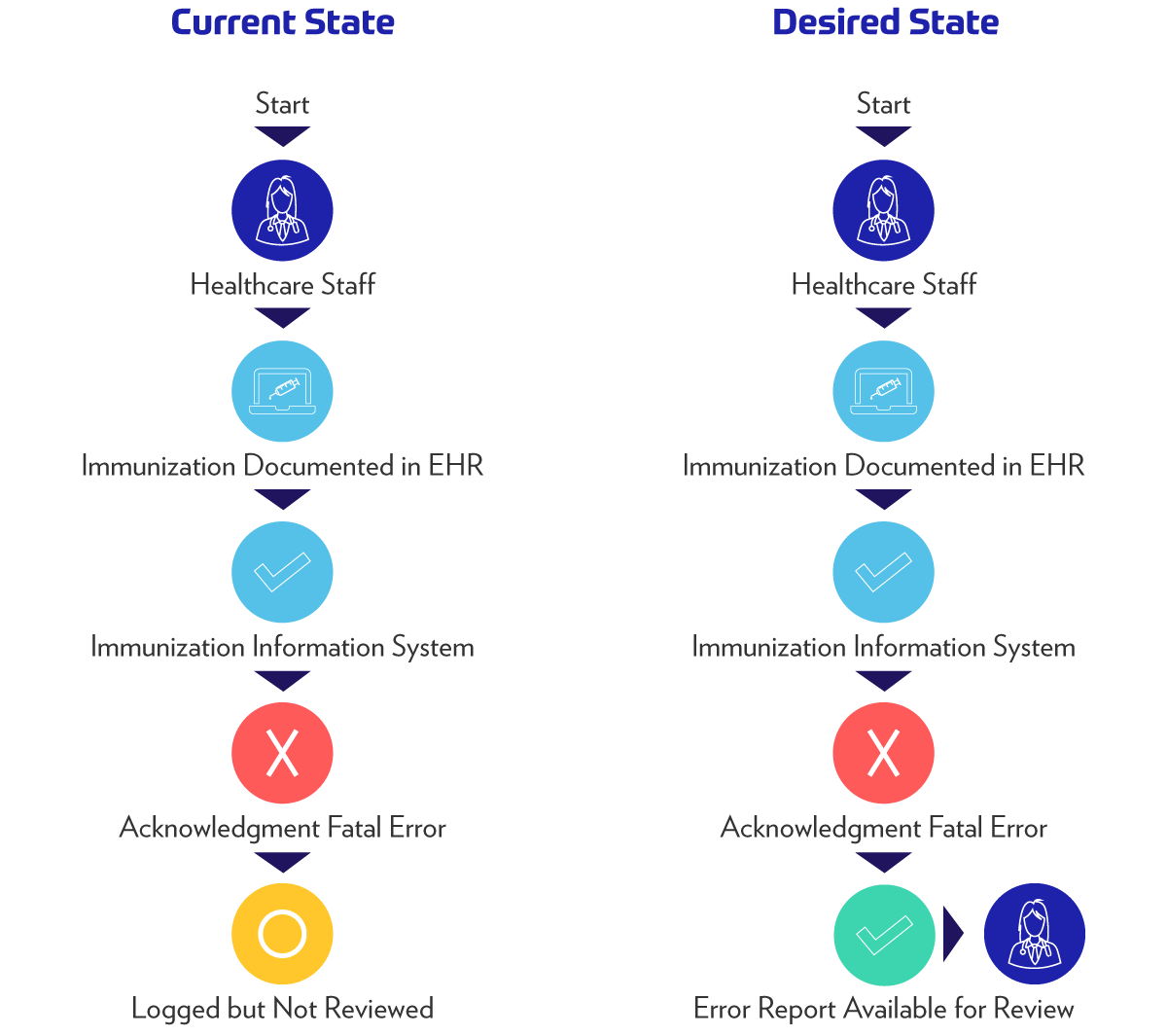
EHRs, pharmacy management and other health information systems exchange patient and immunization data with immunization information systems (IIS). IIS consolidate information from many sources and make immunization data securely accessible to healthcare organizations, public health, schools and others who need to make immunization-related decisions. The COVID-19 pandemic highlights the critical role that IIS play in monitoring vaccination coverage. Efforts to improve IIS data quality impact all populations. However, successful use of IIS relies on exchanging complete, timely, and accurate data between healthcare and public health. New guidance from the Immunization Integration Program (IIP) Acknowledgment Workgroup recommends improving immunization data quality by creating and reviewing reports summarizing submission errors. The ultimate goal of the guidance is to improve the quality and success of immunization submissions to achieve accurate and timely exchange of individual and population-level immunization information.
How Acknowledgment Messages Work
When an immunization is administered to a patient, ideally it is accepted by the IIS and becomes part of the patient’s consolidated immunization history. An IIS sends acknowledgment messages back to the submitting facility indicating whether the immunization message was received successfully or if there were errors. When an immunization cannot be incorporated into an IIS patient’s consolidated record, IIS return an acknowledgment message to the originating system indicating fatal errors. The most common fatal errors occur when data required by the IIS are not provided or data are not recognizable to the IIS (e.g., a patient’s address is missing, or a vaccine’s National Drug Code (NDC) is provided but is not recognized by an IIS). There are a variety of reasons errors like these occur. Perhaps: data was not collected at registration, the EHR was not configured properly, a data entry error took place when data was entered into the EHR, or the IIS has not yet updated its configuration. IIS also send acknowledgment messages for less severe issues. For example, an IIS may request a patient’s phone number be submitted with each record, but if unavailable, the sending system may submit an empty value. In these cases, the IIS may accept the record, but return an acknowledgment message with a warning indicating requested data was not provided. In a single day, there can be thousands of acknowledgment messages with fatal errors, warnings and information. Therefore, it is likely impractical to review these individually.
Currently, healthcare personnel document immunizations in an EHR, records are sent to the IIS and acknowledgment messages are returned to indicate:
- Acceptance
- Errors preventing acceptance
- Warnings
- Information
- Complete rejection due to technical issues
In most implementations, these acknowledgment messages may be stored but are rarely reviewed or summarized, as indicated in the current state workflow diagram below. However, IIS expect acknowledgment messages with fatal errors to be reviewed, corrections to be made to prevent the same error from occurring and the resubmission of corrected data. As indicated in the desired state workflow diagram below, ideally after acknowledgment messages are received, they could be included on a report regularly available for review by healthcare staff, as indicated in the workflow diagram below. Healthcare staff is defined broadly as health information analysts, office managers, registration specialists, or care providers. To support this workflow a designated individual may wish to review a summary report of the most common fatal errors for a given week, investigate further, correct the issue from occurring in the future and resubmit the corrected data.

Workflow for Interoperability between IIS and EHRs Using Acknowledgment Message Data
Importance of Acknowledgment Messages
To better understand the potential impact that rejected vaccine submissions can have upon the immunization ecosystem, the IIP Acknowledgments Workgroup gathered one month of acknowledgment data from eight organizations. Of the more than 72 million acknowledgment messages in the one-month period, 0.8 percent (576,000) of messages communicated fatal errors. If the same rate were applied to the more than 105 million COVID-19 vaccines reported as administered in the United States during the first 90 days of vaccination efforts, more than 852,000 doses may not have been recorded promptly in an IIS. This can underestimate vaccination progress, lead to care providers incorrectly vaccinating patients in the future, waste valuable resources and decrease confidence in data from public health authorities.
Summary of Guidance for Acknowledgment Message Handling
Key points within the guidance include:
- Clinical software, healthcare, IIS and intermediaries all play an important role in monitoring and addressing data quality.
- Acknowledgment summary reports should be produced and used to improve data quality.
- The primary focus of a report should be fatal errors that prevent data from being accepted by the IIS.
- Reports must identify how frequently problems occur and display them in order from most to least frequent to facilitate prioritization.
- Reports must be understandable to non-technical users.
- Reports could include drill-down interactive functionality that allows navigation from a general error category to specific messages or patient demographic and immunization records that generated the error.
- If reports cannot be incorporated into existing tools, software developers should allow advanced users to extract acknowledgment message data that can be used to produce reports in new tools.
While fatal errors are currently communicated, they are most helpful when they are summarized, reviewed and acted upon. The information contained within acknowledgment reports can assist healthcare providers and administrators in knowing what happens to patient data after it is sent to an IIS. Comparing reports over time will enable healthcare staff to examine error trends and confirm error reductions.
Using acknowledgment message summary reports and addressing fatal errors are opportunities to ensure immunization data is accurate, keep patients and communities properly vaccinated and conserve limited resources. Public health, healthcare and health information intermediaries all play an important role in improving data quality.
Decision-makers can help improve immunization data quality by:
- Understanding the value of accurate, complete and timely data
- Allocating resources towards creation and review of acknowledgment message summary reports
- Sharing the IIP Acknowledgments Workgroup full guidance with technical experts, informaticians, software developers and architects who can develop and implement reports or the ability to extract data to enable others to create reports
- Engaging care quality experts who can work to improve clinical workflow and implement needed change identified by acknowledgment message summary reports
- Connecting with the IIP at IIP@himss.org to discuss a spectrum of technical assistance opportunities or strategies for piloting the guidance
Learn more about opportunities to participate as an IIP pilot site or receive technical assistance by contacting IIP@himss.org.
Aggregate Immunization Acknowledgment Message Reports Guidance White Paper
To prepare vaccination provider organizations to handle aggregate immunization-specific acknowledgment message data, an Immunization Integration Program work group developed a guidance document to improve visibility and access to information from acknowledgment messages.



